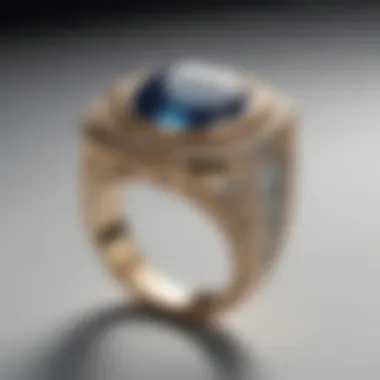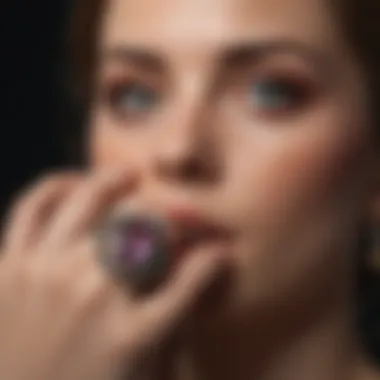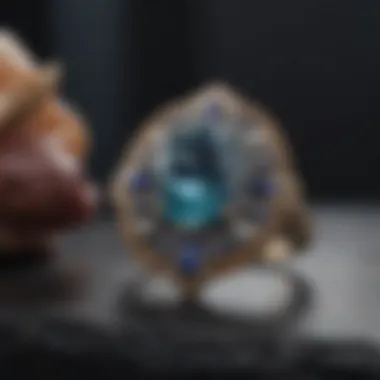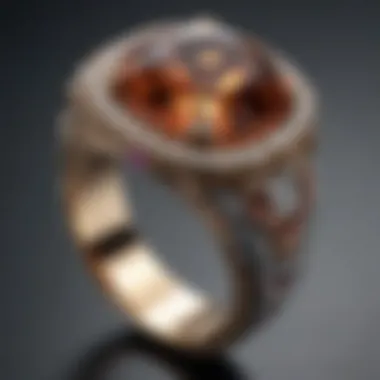Exploring Contemporary Women's Ring Designs


Intro
In the realm of jewelry, rings hold a unique place. They often symbolize personal milestones, emotions, or even status. As fashion evolves, so too does the design and significance of these adornments, especially for women. This article aims to provide an in-depth look into the modern landscape of ring designs for females, considering various styles, materials, and the cultural influences that shape them.
Understanding contemporary rings requires a comprehensive approach. This involves exploring gemstone characteristics, current design trends, and the overall impact on personal expression. Readers will gain insights into how these elements come together to create meaningful jewelry pieces. The following sections will address key aspects of gemstone overview, properties, and trends in women's ring designs today.
Overview of Modern Ring Designs
The exploration of modern ring designs offers valuable insights into the evolution of personal expression through jewelry. Rings, as timeless ornaments, serve not only as adornments but also as representations of relationships, identity, and style. Understanding modern ring designs is essential for enthusiasts and buyers alike. It helps in making informed choices that reflect personal taste and values.
In recent years, the jewelry industry has transformed, catering to diverse preferences influenced by cultural trends, advancements in technology, and innovative materials. This section evaluates why one should pay attention to modern rings, considering their significance in both fashion and personal representation.
Evolution of Ring Designs in Contemporary Jewelry
The evolution of ring designs is closely linked to societal changes and technological advancements. Historically, rings signified status, romance, or allegiance. However, contemporary designs reflect a shift towards unique self-expression rather than mere symbolism.
Materials and craftsmanship have played a pivotal role in this evolution. Today, the introduction of sustainable practices and alternative materials reshapes how rings are made. Consumers increasingly value ethical sourcing and environmental concerns. Thus, modern rings often incorporate recycled metals and lab-grown gemstones, offering choices that align with personal ethics and style.
Furthermore, the aesthetics of modern rings have diversified. While traditional designs maintain their appeal, there is a marked preference for personalized and bespoke creations.
Cultural Influences on Modern Rings
Cultural influences significantly shape modern ring designs, with designers drawing inspiration from global traditions and history. This intercultural exchange enriches the jewelry landscape, allowing for a variety of styles that cater to different tastes.
Various cultures incorporate specific motifs, colors, and techniques that resonate with their heritage. For instance, some modern rings reflect intricate patterns seen in African art or minimalist shapes inspired by Scandinavian design. Consumer interest in such diverse representations emphasizes a demand for authenticity and unique narratives within jewelry.
Designers often collaborate with artisans worldwide to blend traditional craftsmanship with modern aesthetics. This approach not only honors cultural practices but also supports local economies and sustains artistry through generations.
In summary, modern ring designs encapsulate a complex interplay of history, culture, and contemporary values. Understanding this interplay enhances appreciation for these unique pieces and their role in personal expression.
Materials in Modern Ring Designs
Understanding the materials used in modern ring designs is essential for anyone interested in jewelry, whether a buyer or an enthusiast. The choice of material not only impacts the aesthetic but also the durability, maintenance, and price of the ring. Rings have moved beyond traditional materials to include alternative options that express personal style and values. This section will explore both traditional and alternative materials for modern rings, focusing on their unique characteristics and their role in the current jewelry landscape.
Traditional Materials
Gold
Gold is often seen as the epitome of luxury in jewelry. Its luster and rich color make it a timeless choice. When considering gold for rings, buyers typically evaluate karat weight, which indicates the purity of the gold. Higher karat gold, like 18k or 22k, is purer but softer, making it more prone to scratches.
The key characteristic of gold is its malleability, allowing artisans to craft intricate designs. Gold is a popular choice due to its excellent resistance to tarnish. One unique feature is its ability to be alloyed with other metals, which can enhance strength while providing various color options, like white or rose gold. A consideration is that with time, gold can develop scratches, requiring occasional polishing.
Silver
Silver, particularly sterling silver, is another traditional choice for rings. It is known for its bright, shiny surface and affordability compared to gold. Sterling silver consists of 92.5% pure silver, making it more durable than pure silver.
The key characteristic of silver is its cool tone and high reflectivity. Many designers favor silver for its versatility in contemporary and vintage designs. A unique feature of silver is its ability to be oxidized, which creates a distinctive dark finish, popular in trendy jewelry. However, silver tarnishes over time, requiring regular cleaning to maintain its brightness.
Platinum
Platinum is regarded as the most prestigious metal in the jewelry world. It is denser and heavier than gold and silver, providing a luxurious feel. The key characteristic of platinum is its exceptional durability. This makes it an ideal choice for everyday wear, particularly for rings.


One unique feature of platinum is its hypoallergenic properties, making it suitable for those with sensitive skin. Unlike gold, it does not lose metal over time, as its surface can be polished to remove scratches, thus maintaining its weight and integrity. The downside is its higher price point, which may limit accessibility for some buyers.
Alternative Materials
Resin
Resin rings offer a modern and artistic approach to ring design. They are made from synthetic materials which can be easily molded into various shapes and colors. The key characteristic of resin is its versatility; it can incorporate colors or even small objects, creating unique designs.
Resin becomes a popular choice because it allows for customization often not possible with traditional metals. A unique feature is the weight, as resin rings are lightweight and comfortable to wear. However, resin can be less durable than metals, and they should be protected from prolonged exposure to heat and direct sunlight to prevent deformation.
Wood
Wood rings are gaining traction as an eco-friendly option. These rings are crafted from sustainably sourced materials, merging nature with elegance. The key characteristic of wood is its natural beauty; grains and patterns are unique to each piece.
Wood can be a beneficial choice for those looking for an organic feel in their jewelry. A unique feature of wood is its biodegradability, resonating with environmentally conscious consumers. However, wood rings may require proper care to avoid damage, especially in wet conditions; some may prefer to avoid them for everyday wear.
Stainless Steel
Stainless steel has become a favorite for modern ring designs due to its strength and corrosion resistance. It is often used in men’s and women’s rings alike, offering a contemporary look. The key characteristic of stainless steel is its durability; it withstands scratches and dents much better than softer metals.
Its affordability makes it a popular choice for those wanting modern design without high costs. A unique feature is that it can be combined with other materials, such as gemstones or wood, for diverse aesthetics. On the downside, some may find stainless steel less appealing due to its industrial appearance compared to precious metals.
The choice of material in ring design reflects both personal style and practical considerations, influencing long-term satisfaction with the jewelry piece.
Popular Styles of Rings for Women
Understanding popular styles of rings for women offers insight into how personal expression is intricately woven into the very fabric of jewelry design. These styles showcase the versatility of rings, highlighting the way different aesthetics resonate with different personalities. Popular styles also reflect cultural trends, individual tastes, in addition to the emotional significance attached to jewelry. Women today use rings not just for decoration but as symbols of identity, memory, and status. This section explores several significant styles.
Minimalist Designs
Minimalist designs focus on simplicity and understated elegance. These rings usually feature clean lines, geometric shapes, and a limited number of embellishments. The goal is to provide a subtle statement rather than a bold declaration. These rings cater to individuals who appreciate a modern aesthetic without the frills. They can be effortlessly paired with any outfit, making them suitable for both everyday wear and more formal occasions. The charm of minimalist designs lies in their ability to enhance one's look without overwhelming it.
Statement Rings
Statement rings are designed to stand out. These pieces often boast larger stones, intricate settings, or unique designs that draw immediate attention. They serve as conversation starters and are well-suited for social gatherings and occasions where one wishes to make an impression. The boldness of a statement ring is more than just its size; it captures the wearer's personality and can signify confidence and individuality. Choosing a statement ring allows one to express unique style and make a lasting impression.
Vintage-inspired Designs
The allure of vintage-inspired designs draws upon nostalgia and history. These rings often incorporate intricate patterns or unique craftsmanship reminiscent of specific eras, such as Art Deco or Victorian styles. They carry a sense of charm and a story that modern designs may not possess. This style appeals to those who appreciate timeless beauty and often seek pieces that connect them to the past. Vintage-inspired rings often have a romantic quality, inviting wearers to celebrate tradition while embracing contemporary fashion.
Nature-inspired Rings
Nature-inspired rings reflect the beauty of the natural world. They often incorporate organic shapes, earthy tones, and materials like wood or stones that remind one of the outdoors. This style connects wearers to nature, conveying a sense of harmony and tranquility. Furthermore, these rings are increasingly popular among environmentally conscious consumers. By choosing pieces made from sustainable materials or designs that celebrate natural forms, wearers express their appreciation for the planet and promote ecological awareness.
"Jewelry, and especially rings, have transcended mere ornamentation. They communicate identity, values, and emotions to the world."
Each of these styles embodies a unique approach to modern ring design. They open avenues for self-expression and foster connections with cultural and personal narratives. Understanding these popular styles enriches one’s perspective when selecting the perfect ring, aligning it not just with individual taste but also with the deeper meanings they carry.
Gemstone Choices for Modern Rings
The choice of gemstone significantly influences the character and appeal of modern rings. Gemstones not only provide aesthetic qualities but also carry symbolic meanings, durability, and value. Selecting the right gemstone requires an understanding of its unique properties and the emotions it conveys. This section examines various gemstone choices and their contributions to modern ring design, catering to different preferences and values.
Traditional Gemstones


Diamonds
Diamonds remain the most popular choice when it comes to luxury jewelry, especially in engagement rings. Their remarkable hardness is a key characteristic; this makes them extremely durable. Diamonds are often seen as a symbol of eternal love and commitment. This powerful association adds to their appeal. The unique feature of diamonds is their ability to reflect light, known as brilliance. This effect enhances the aesthetic appeal of the ring. However, ethical concerns regarding diamond mining have led many consumers to seek alternatives, which is a drawback in some contexts.
Sapphires
Sapphires are another widely appreciated gemstone in modern rings. Known for their rich color and durability, they offer a beautiful alternative to diamonds. The striking blue hue is the most recognized, but they also come in various other colors. Sapphires symbolize wisdom and nobility, which adds to their allure. A unique aspect of sapphires is their versatility, suitable for both casual and formal settings. An advantage of sapphires is that they tend to be less expensive than diamonds while still boasting impressive quality, making them a practical choice for many.
Emeralds
Emeralds are cherished for their vibrant green color and unique inclusions, known as "jardin." This characteristic makes every emerald distinct. They are often considered a symbol of growth and renewal. Emeralds hold significant cultural value, notably in various traditions and symbolizes hope. One downside of emeralds is that they require careful handling due to their relatively lower hardness compared to diamonds and sapphires. This makes them somewhat more vulnerable to scratching.
Unique and Alternative Gemstone Options
Moissanite
Moissanite has gained popularity as a diamond alternative in modern ring designs. Known for its brilliance, it actually outshines diamonds in terms of refractive index. This brings a unique sparkle that many find appealing. Additionally, moissanite is more affordable than diamonds, making it accessible to a broader audience. Its benefits include ethical sourcing since it is lab-created, addressing some environmental concerns. However, some purists still prefer natural stones and may overlook this option.
Lab-created Stones
Lab-created stones represent another modern choice for gemstones. These stones often mimic the appearance of natural gems while being produced in controlled environments. They are known for their purity and can be tailored to exact specifications. The advantage of lab-created stones is their affordability and conflict-free status, appealing to environmentally conscious buyers. Nonetheless, traditionalists might have a preference for naturally sourced stones, perceiving them as more valuable or authentic.
Unconventional Gemstones
Unconventional gemstones are gaining traction in the world of jewelry design. These include stones such as opals, garnets, and even semi-precious gems. They offer unique colors and patterns, allowing for highly personalized ring designs. One key characteristic of unconventional gemstones is their individuality, which appeals to those seeking something distinct. The advantage here is authenticity, bringing a personal touch to jewelry. However, they may come with lower resale value compared to traditional options, which is worth considering.
Customization in Ring Design
Customization in ring design holds a distinguished place in modern jewelry as it allows individuals to express their uniqueness. In an era where personal style matters significantly, tailoring a ring to reflect one’s personality and preferences becomes essential. The process of customizing rings helps in creating meaningful pieces that resonate with the wearer. This section will detail the bespoke design process and the significance of engravings and personal touches that enhance the customization experience.
Bespoke Design Process
The bespoke design process is a collaborative effort between the client and the jeweler. It begins with discussions on ideas, inspirations, and specific requirements. Initial sketches may be presented, giving clients a visual reference of their envisioned design.
Important steps in the bespoke process include:
- Consultation: A conversation to explore the client's vision, desires, and budget.
- Sketching: The jeweler creates initial designs based on the client's input. This step is crucial as it visually presents the concepts that will take shape.
- Choosing Materials: Selecting appropriate metals and gemstones involves consideration of aesthetics and practicality. Clients gain insight into how different materials can interact, affecting the final look and durability of their rings.
- Approval and Iteration: Client feedback is vital at this stage. Changes can be made to ensure the design meets expectations before moving forward.
- Finalization: After various iterations, a final design is crafted, leading to the physical creation of the ring.
This entire process empowers clients, transforming their ideas into tangible art. Choosing to customize not only results in a unique piece but also infuses personal stories into the jewelry, making it irreplaceable.
Engravings and Personal Touches
Engravings provide an opportunity for clients to add significant details to their rings. This might be a meaningful date, a name, or a short message that resonates with the owner. Such personal touches can elevate a ring from a simple accessory to a cherished keepsake.
Considerations in adding engravings include:
- Font Styles: The choice of font can influence the overall feel. Elegant scripts may suggest romance, while block letters could convey strength.
- Placement: The location of the engraving impacts visibility and sentiment. Inside the band remains discreet, while external engravings make a statement.
- Size and Length: The message's length should be appropriate for the chosen space to maintain readability and aesthetics.
Overall, engravings add emotional depth to rings, linking them to personal milestones or relationships. Choosing to incorporate custom elements into ring designs fosters a deep connection between the piece and its owner.
"Custom rings are not just jewelry; they're a narrative of personal identity."


Trends in Ring Designs
Trends in ring designs underscore the dynamic nature of contemporary jewelry. It reflects societal movements, environmental concerns, and technological advancements. Understanding these trends is vital for both consumers and designers alike. It helps them navigate the complexities of personal taste, ethical considerations, and innovative developments in jewelry making. Consequently, trends provide a framework to explore not only the aesthetics of rings but also their significance in modern culture.
Sustainability in Jewelry Making
Sustainability has emerged as a crucial element in the jewelry industry. The environmental impact of mining and manufacturing processes has pushed consumers toward more responsible choices. Modern ring designs often incorporate ethically sourced materials. These materials could be recycled gold or eco-friendly gemstones that minimize ecological damage.
For instance, brands like Brilliant Earth focus on ethically sourced diamonds. These diamonds are harvested in ways that do not harm the environment or communities.
Additionally, sustainable practices ensure that the artisans and labor involved in the making of rings are treated fairly. Consumer awareness of these factors influences buying patterns. This creates a demand for brands that adhere to sustainable principles.
This shift in consumer preferences highlights the importance of transparency in the jewelry business. Buyers want to know where their jewelry comes from and how it is made. Understanding these factors enhances their purchasing decisions.
Smart Rings and Technology Integration
Smart rings are gaining popularity in the modern ring market. These innovative pieces combine traditional aesthetics with the latest technology. They provide users with functionalities such as health tracking and notifications.
Smart rings like Oura and Motiv provide insights into a person's wellness by monitoring sleep, activity, and heart rate. This makes them appealing to health-conscious consumers.
Moreover, integrating technology into jewelry allows for personalization that was not achievable in the past. Users can customize settings based on their preferences.
The intersection of technology and jewelry exemplifies how modern consumers seek multifunctional pieces. It creates a blend of style and practicality that resonates especially with tech-savvy individuals.
Caring for Modern Rings
Caring for modern rings is essential for maintaining their beauty and integrity. Rings are more than mere accessories; they often represent significant moments or personal milestones in one’s life. Hence, ensuring their care is critical. Proper maintenance extends their lifespan and preserves their aesthetic appeal, allowing the wearer to enjoy them for years to come.
Caring for rings can encompass various practices, including cleaning, storage, and occasional inspections. These actions help to prevent damage from wear and tear. Furthermore, understanding how to care for different materials and gemstones ensures that one can make informed choices that suit the specific needs of the ring. Each ring’s style, from minimalist designs to ornate statement pieces, might require a unique approach in care.
Cleaning Your Rings
Cleaning rings regularly is fundamental for preserving their shine and brilliance. Dust, oils from the skin, and exposure to harsh chemicals can dull the appearance of both the metal and any gemstones set in them.
Here are some effective methods for cleaning rings:
- Mild Soap and Water: For regular maintenance, use a soft cloth and a mixture of mild soap and warm water. Gently scrub the ring to remove dirt and oil. Rinse thoroughly and pat dry with a soft, lint-free cloth.
- Ultrasonic Cleaners: These devices can remove grime effectively. However, care should be taken, especially with delicate stones. Avoid using these cleaners on porous or soft gemstones like pearls or opals.
- Jeweler’s Cleaners: Professionally formulated solutions can be used as well. Always follow the provided instructions to avoid damage.
It’s advisable to clean rings regularly depending on wear. For rings worn daily, monthly cleaning might be sufficient. On the other hand, rings worn less frequently may only need cleaning before special occasions.
Storage Solutions
Proper storage of rings is equally important. Storing rings incorrectly can lead to scratches, tangles, and damage over time. Here are some practical storage solutions:
- Ring Boxes: Keeping rings in separate boxes or a dedicated ring box helps. These containers prevent rings from coming into contact with each other, reducing the risk of scratches.
- Antique or Soft Cloth Pouches: For rings not worn frequently, these pouches can provide effective protection against dust and scratches.
- Jewelry Trays with Compartments: These allow for organized storage, making it easy to view and select rings without the risk of tangling.
Consistently practicing these storage tips can ensure that each piece maintains its charm and does not suffer unnecessary damage. By emphasizing care in cleaning and storage, one can protect their investment in modern rings and continue to express their individuality through fine jewelry.
Epilogue
In this article, we explored contemporary ring designs for women, focusing on various styles, materials, and cultural influences. The conclusion emphasizes several important considerations regarding the future of jewelry design in this evolving landscape.
One of the key elements is personal expression. As ring designs become more innovative, they offer individuals the opportunity to showcase their unique identity. This shift towards personalization in jewelry is significant as it reflects broader societal trends towards self-expression.
Additionally, sustainability plays a crucial role in the future of ring design. Consumers are becoming more aware of the environmental impact of their purchases. Many now favor ethically sourced materials and sustainable practices.
Moreover, technological integration is reshaping the jewelry market. Smart rings, equipped with health monitoring and connectivity features, are gaining traction. This trend indicates a blend of functionality and artistry, appealing to modern consumers who value practicality alongside aesthetics.
To summarize, the outlook for modern ring designs is promising. Increased personalization, sustainability, and technology are likely to dominate future trends. These factors not only enhance beauty but also underscore the significance of rings as a means of expressing individuality and values.



